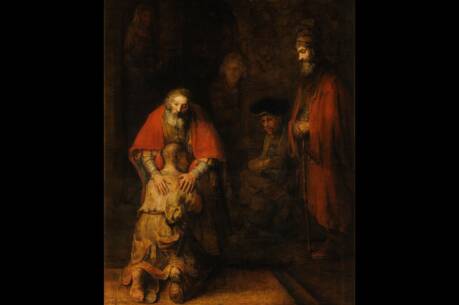Dream Visions and a Sign in the Heavens
The readings of the Christmas cycle are like a large tapestry, in which you can follow the narrative sequence of the birth and infancy of Jesus or pause before one scene of particular beauty. The liturgical cycle does not proceed in linear fashion, since the celebration of the Holy Family and the flight to Egypt precede the solemnity of Mary and naming of Jesus, while the cycle concludes with the visit of the magi, which precipitates the flight. Each narrative is a miniature of the mystery of God’s sending his Son, born of woman so that we might receive adoption as sons and daughters.
“Rise, take the child and his mother, and flee to Egypt” (Mt 2:13)“The Lord look upon you kindly and give you peace!” (Num. 6:26)
The Holy Family could well be called the Refugee Family. No sooner had the night visitors laid their gifts at the infant’s feet than Joseph receives another command from God’s messenger: Rise, take the child and his mother, and flee to Egypt. Though Jesus is scarcely arrived on this earth, his future is determined by a brutal murderer, Herod the Great, who, after killing many members of his own family, would have few qualms about killing dozens of newborn children. How sadly contemporary such a picture is, when the anxious faces of refugee families from Ethiopia, Rwanda, Kosovo and now Afghanistan fill our television screens.
Joseph’s nighttime departure to Egypt, however frightening, is to fulfill God’s plan to call his son out of Egypt, just as God’s first love, Israel, was called forth from slavery and oppression in Egypt. Though Scripture tells us nothing about the sojourn of the family, their return plummets them into further danger from Herod’s son, and they return to Nazareth, where now he who was heralded as Jesus, Savior and God With Us, is now simply a Nazorean, a designation later used disdainfully for Christians.
Suddenly the Christmas lights begin to dim. A holy family is not necessarily one secure from threatening dangers in the first century or today. The image of the flight of the Holy Family suggests today that the constant concern over family values must be joined to a struggle for the dignity and rights of every family.
The celebration of the Holy Family is joined closely to the observances of the octave of Christmas and the motherhood of Mary. Three themes echo through the readings: the gracious love of God manifest in the gift of his Son, born of woman; Mary keeping (treasuring) these things in her heart; and the circumcision of Jesus. After repeating the story of the visit of the shepherds from the Christmas Mass at Dawn, the story of the circumcision is narrated briefly. I remember from my childhood that only this section was read and was welcomed as the shortest Gospel of the year, appropriate for the day after New Year’s Eve. To a very young child the name of the feast had an aura of awe and mystery, especially when illustrated by artwork showing Mary and the infant next to a religious official with a big knife.
The verb used for keeping or treasuring appears in Gen. 37:11 and Dan. 4:28, with the nuance of trying to fathom the deeper meaning of particular messages. Mary also reflects on them. Mary is the one who not only physically gives birth to God’s son; she continues to hear and ponder the meaning of God’s word. From the first moment of her appearance (Lk. 1:26-38), Mary is the model disciple who hears and follows God’s word, even amid uncertainty.
The Lectionary divides the narrative poorly, since the circumcision and official naming of Jesus form the prelude to the presentation and the meeting with Anna and Simeon (2:22-38), so that the whole infancy narrative begins and ends in the Temple. The entire scene serves to portray Jesus as bearing the sign of the covenant, as a child of Abraham, and his parents as Jews faithfully fulfilling the Torah. Christians today might reflect on Pope John Paul II’s famous statement in 1980 that God has made with the Jewish people an irrevocable covenant, the sign of which Jesus bore in his human flesh.
This article also appeared in print, under the headline “Dream Visions and a Sign in the Heavens,” in the December 24, 2001, issue.







